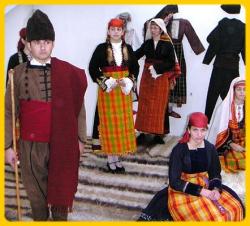|
| Why did our forefathers bother to wear waistbands? |
|
|
 In Bulgarian folklore clothing was accepted as a spitting image of the man wearing it. Unsurprisingly then, clothing absorbed the symbolism of the respective parts of the human body. The waistband and the belt correspond to the waist – an important part of the human body, often considered a weak point that should be protected from both cold and physical strain. It was presumed as even more important for the reproductive ability of men. Hence the proverb, A strong waist, a strong family.
In Bulgarian folklore clothing was accepted as a spitting image of the man wearing it. Unsurprisingly then, clothing absorbed the symbolism of the respective parts of the human body. The waistband and the belt correspond to the waist – an important part of the human body, often considered a weak point that should be protected from both cold and physical strain. It was presumed as even more important for the reproductive ability of men. Hence the proverb, A strong waist, a strong family.
In a symbolical aspect the waist is the middle, the half of the torso that connects its upper part associated with rationality and spirituality, with the lower part associated with lust. This host of meanings is transferred to the waistband – it was capable of connecting and uniting the opposites. With the female body the waistband was also linked to the tummy, the source of female fertility. It is not accidental that the waistband can also denote kinship – people that belong to the same large family were said to be from the same waistband.
As part of the costume the waistband kept the rest of clothing firmly attached in place. It was tucked over them. The waistband should be worn, quite tight and attached with a pin. In this way the man wearing it looked upright and neat – tightened in both the literal and figurative sense, and looking good. If he was not wearing his waistband tightly the man was accepted as slovenly, and plain, a laughing stock. Untidy clothing of spouses may mean infidelity. It was believed that when the man’s waistband was dragging behind his wife was cheating him, and when the strings of the woman’s apron were dragging behind, her husband flirted with other women. In traditional culture the adjective slovenly (also untidy, wearing his waistband loose) has negative connotations including lack of moral values, often in sexual behavior too.
The waistband as a sign of norm and measure is an accessory involved in the plots of legends. According to some of them, God gradually created three waistbands of people. The giants and dwarves proved inadequate, while humans “worked” in earthly conditions. God ordered them to get tightened around the waist and thus remember, they are medium-sized. There was also the notion of the three worlds in which people with differently tucked waistbands lived.
The waistband often took center stage in customs and rituals. Until the baptizing, the child would be wrapped in cloths from old garments and was tied with a string. Once he or she was officially christened, it was dressed in his or her own clothes including a special waistband (povoy) signifying its acceptance in the human community. The transition from life to death was also accompanied by a range of rituals. When a man or woman was in agony, his or her clothes were untied and unbuttoned and the waistband was removed. This was a way to make sure that the soul would more easily leave the body. At the funeral however, the waistband was put again so as to add dignity of the deceased’ man’s passage to the yonder world. This was valid for little children and there is a song about a baby that was buried without a waistband. It reproached his mom, because in the yonder world a wood-nymph asked him to pick herbs, and he had no waistband to keep them there, so they fell all the time and the wood-nymph beat him.
Tucking with a waistband signifies the sexual maturity of the boy. The expression “We tied his waistband” in fact means “he has grown up, he is already a man”. With women, tying a waistband is also a signal of major moments of transition. In some regions of the country girls put waistbands at the start of their menstrual cycle, and in other regions – once they get engaged or married. The female woven belt with clasps is given to the young bride on the wedding day and she wears the accessory until her death. In other parts of Bulgaria, women began wearing waistbands after they got pregnant.
The most ancient mode of veiling the bride during the traditional wedding was with a red male waistband. In certain villages the bride and bridegroom were taken out of church or are ushered into the bridegroom’s home tied together with a waistband. If a man cut his wife’s belt this meant he wanted to leave her. There is a story of how a man cut his wife’s waistband and so the two had to split though they in fact loved each other dearly.
As a matter of interest, many Bulgarian dialects use a Greek word – zouna – to denote the waistband or belt. The word means rainbow. In contrast in some dialects the word for waistband also means rainbow. In all likelihood, the analogy arose from the appearance of some female belts designed with horizontal colorful stripes that looked like the rainbow. On the other hand, the rainbow was often compared with a waistband. The phrase “God threw up the waistband” means “the rainbow is up”. There was also the concept of the rainbow being a serpent drinking water from the river, and in turn the belt is likened to a serpent. One example is the riddle that goes like this: „A colorful snake around the beech: what is it?” The answer is, “the belt”.
http://bnr.bg |
| Tuesday, Jun 18, 2013 |
|
|
|
|
| » RENTALS |

|
|
|
| Apartment |
€ 410 |
|
| Location: |
Veliko Tarnovo |
|
|

|